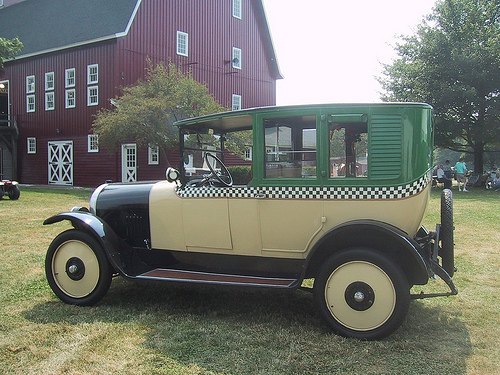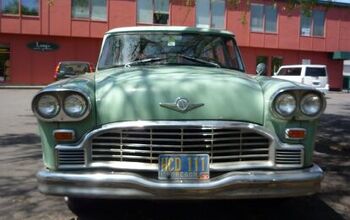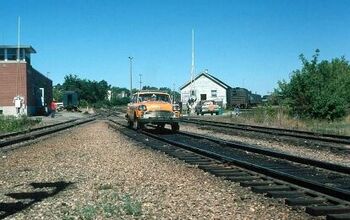An Illustrated History Of Checker Motors

[Note: Three related Checker posts: 1967 Marathon Curbside Classic; Vintage Checker Ads; and Tomorrow’s Checker? Also note that these pictures were found at a variety of sites, but it appears that the original source for most of them were posted on this Flickr account by Drivermatic. Thanks for the superb photographic resource!]
For sixty years, Checker Motors had a record unbroken run of profits building a few thousand cars per year in a small little factory in Kalamazoo, Michigan. In 1981, it posted its first loss, $488,326, and its owner made good on his threat to stop production of the iconic Marathon if his workers didn’t accept wage concessions. But Checker continued to stamp out body parts for GM into 2009, including for the Buick LaCrosse. The Carpacolypse of 2009 finally shuttered the ancient plant, but no need to shed a tear for the original owner’s son, David Markin: his wealth is estimated at over $100 million. And it was all due to a shrewd investment of $15,000 that his father made in 1920, which put him in the driver’s seat of Checker Motors. Let’s take a ride through Checker’s history. Taxi!
To understand the origins of Checker, one has to know that the taxi business was once very different than now: two or more companies competed fiercely in each city for the growing and lucrative business in those days. If you want the remarkable details of shady deals, graft and stock manipulation that created the two largest cab companies, Yellow and Checker, head over to coachbuilt.com‘s very detailed history. A slightly less detailed but also excellent Checker history is also at checkertaxistand.com. Lets just say the upshot was that Checker Cabs wanted a custom built taxi, and somehow the son of a poor Russian tailor, Morris Markin, cleverly managed to manipulate himself (and some stock holdings he managed to get revalued) in the position to provide it, the first Checker Model C of 1922.
It’s important to remember that in the twenties, there were dozens of small car manufacturers, so in its early days, Checker’s scale wasn’t at all unusual. And the factory instantly became a profitable enterprise. And Markin expanded his holdings with Checker stock and profits including some large taxi operating companies and in later years truck trailer building (Great Dane) and other businesses.
During this period, taxis competed on prestige, size and comfort, as most working folks stuck to taking the streetcar or bus. The Checkers from the late twenties were large handsome cars, and as in the old coach-built tradition, often had a rear roof section that could be lowered in nice weather, as much as to be seen as to see.
Checker styling started becoming a bit adventurous in the thirties, but the the full degree of that was still a few years off.
As always, Checkers were designed specifically for the job, both in their layout and rugged construction.
The all-new 1939 Model A feature a highly bizarre front end whose only redeeming feature was that it was recognizable from half a mile away. The debate who designed it is still unresolved, but actually, from the front end back, it was a quite a conservatively styled sedan with a highly unusual feature.
It had a remarkably advanced (and patented) optional steel rear laundalet roof section that could be lowered as seen here.
Rather unusual for such a small company, Checker ambitiously explored advanced designs during the forties, including this one-off rear-engined prototype. Looking all the world like a giant Fiat 600 Multipla, it was probably for the best that it was not developed further.
But a FWD prototype, with the straight six in a transverse arrangement was built and seriously considered. This is the first I’ve seen or heard about this, and its quite a remarkably advanced design for the times, looking much more French than Kalamazoo. Technical difficulties with the FWD transaxle killed it, probably for the best in terms of preserving the Checker reliability reputation.
The conventional new A6 of 1946 had traditional styling, and with minor retouches, was the iconic cab of the post war era.
Like the legendary later Aerobus, Checker was building extended wheelbase vehicles in the forties, like this six door, twelve passenger wagon. These were the shuttle buses of their day.
In 1955, an all new Checker was developed in their advanced styling sudios (a corner of the factory partitioned off with drapes). The new A8 was designed to meet Manhattan’s new taxi regulations, and featured independent suspension on the front for the first time. Not that it made the Checker famous for its ride, however. The suspension engineering department lived in the janitor’s closet.
Interior space was always the highlight of the Checkers, and the Marathon’s tall roof, totally flat floor and two folding jump seats meant that up to five patrons could be accommodated in the rear compartment alone. Guess who got the jump seats? The pretty young lady. Beats sitting in the guys’ laps, anyway.
There’s a treasure trove (143) of vintage Checker photos that have been posted at this Flickr account, the source of many of the pictures here, including an extensive tour of the Checker factory led by this charming and knowledgeable woman, who here is pointing out the finer details of Checker’s legendary frame, the source of its ruggedness and flat floor.
The six and eight-door Aerobuses were the stuff of legends in their day. Unlike today’s stretch limos with their cut and welded frame extensions, these long boys sat on a completely unique and specially designed frame, and enjoyed a high degree of structural integrity.
Not surprisingly, the rugged Checker frame lent itself well to custom coachbuilding, like this Swiss ambulance. It was the Checker’s taxi cab image that probably kept it from more success in the US as a limo and hearse source. If folks couldn’t afford a Cadillac while they were still alive, they at least wanted to ride to their graves in one.
Checker also made an extended body sedan, and pushed it as a limo alternative, including versions with padded roofs and even an opera window. But time was moving on, and the garish seventies made the Checkers look like stale bread.
Checker Motors operated most profitably with an annual production of 6-8k cars, but after 1970 that became increasingly difficult, due to major markets like NYC loosening their taxi regulations to allow conventional sedans to operate. They were obviously cheaper for the Big Three to build, and the fleet dumping practices of the seventies was Checker’s coffin nail as a producer of cars. In 1981, Checker had its only posted loss after some sixty years, having survived the Depression profitably, if on a smaller scale.
Former GM President Ed Cole bought 50% of Checker for $6 million and began plans to build a completely new car for a new era. His first prototypes were based on lengthened VW Rabbits, but his death at the controls of his personal airplane ended that. But some work continued based on his ideas, and utilizing GM’s X-Body (Citation) FWD drivetrain and a solid rubber rear suspension spring. Checker founder’s son David Markin was more interested in tennis than new adventures, and it all came to naught.
But Checker continued to build parts until 2009, when the downturn finally swamped them too. The little factory that hummed away for almost ninety years has been razed, leaving just the footings to mark where one of the more unusual automotive stories played out.

More by Paul Niedermeyer
Latest Car Reviews
Read moreLatest Product Reviews
Read moreRecent Comments
- 3-On-The-Tree I have a 2009 C6 Corvette LS3 and the only major repair that I have done on it was replace the radiator. Besides usual plugs, wires oil etc. And yes those tires are expensive as well.
- 28-Cars-Later We had a red 2003 with less than 100 miles in late 2004/5ish and kept it till the end AFAIK. I do recall being told we had about $28,000 in at the time (about $43,6 in 2023 Clown World Bux). I don't ever recall anyone retail even looking at it, and it lived in the showroom/garage."It's an automatic that just had the linkage repaired and upgraded"This really doesn't bode well. Maybe there's a upgrade I'm simply not aware of so one could tune the 3rd Gen LM4 for higher power but messing with it isn't making me smile because now I know its no longer factory or somehow it broke and with such low miles I'm equally concerned.
- Analoggrotto With Kia Hyundai you are guaranteed to have the best Maintenance and Service experience in the industry. Complementary diagnostics, open book fees schedules and adherence to published rates with no attempts to tack extra work on are part of the HMC Gold Standard of Service. Recalls are the lowest in the industry but when you bring your Hyundai Genesis Kia vehicle in for Feature Improvement, rest assured that it will be taken care of to the highest pentagon standards, fully free of charge with no pressure for paid work or service unless requested. Hyundai Kia have the highest levels of customer ATP loyalty in the industry and Service is key to the best after sales experience.
- MaintenanceCosts In Toyota's hands, these hybrid powertrains with a single motor and a conventional automatic transmission have not been achieving the same kind of fuel economy benefits as the planetary-gear setups in the smaller cars. It's too bad. Many years ago GM did a group of full-size pickups and SUVs with a 6.0L V8 and a two-motor planetary gear system, and those got the fuel economy boost you'd expect while maintaining big-time towing capacity. Toyota should have done the same with its turbo four and six in the new trucks.
- JMII My C7 isn't too bad maintain wise but it requires 10 quarts of expensive 0W-40 once a year (per GM) and tires are pricey due size and grip requirements. I average about $600 a year in maintenance but a majority of that is due to track usage. Brake fluid, brake pads and tires add up quickly. Wiper blades, coolant flush, transmission fluid, rear diff fluid and a new battery were the other costs. I bought the car in 2018 with 18k in mileage and now it has 42k. Many of the items mentioned are needed between 20k and 40k per GM's service schedule so my ownership period just happens to align with various intervals.I really need to go thru my service spreadsheet and put track related items on a separate tab to get a better picture of what "normal" cost would be. Its likely 75% of my spend is track related.Repairs to date are only $350. I needed a new XM antenna (aftermarket), a cargo net clip, a backup lamp switch and new LED side markers (aftermarket). The LEDs were the most expensive at $220.




















































Comments
Join the conversation
I like the 1939 model A cab and so do a lot of fellow model train buffs who have made scale models of NYC in 1/48 scale with trolleys and elevated trains along with the models of the 3 rd Ave trolleys and buses these types of taxis would be the perfect thing, would there be any way 1/48 scale models be made of these model A taxis ? not just for model train builders but also for model car collectors as this was a unique taxi.
The only thing left today is the test track.